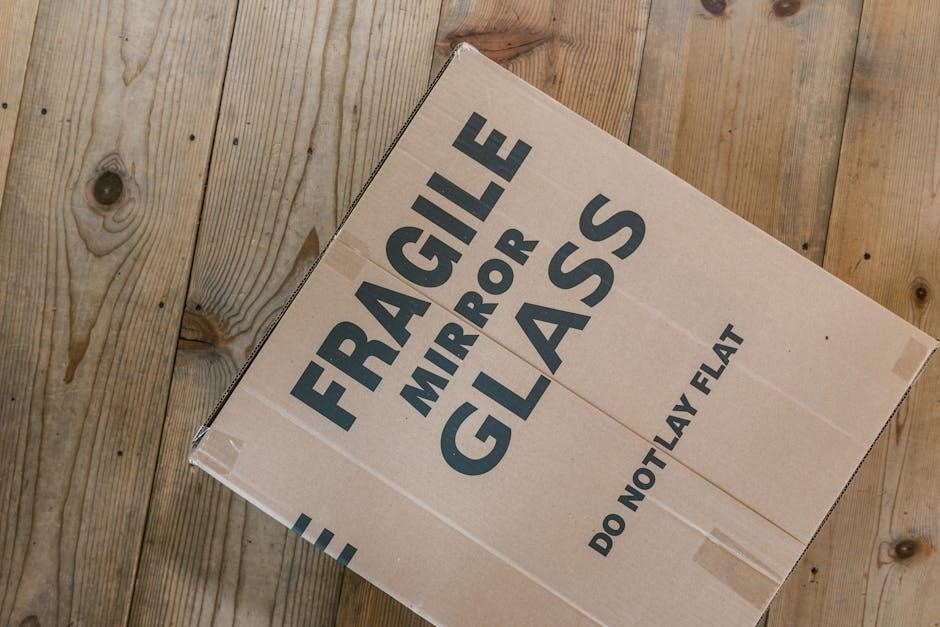The Salivette Cortisol is designed for precise saliva collection to measure cortisol levels․ It offers a non-invasive method, ensuring reliable results when instructions are followed․ Ideal for clinical and home use․
1․1 Overview of Salivette Cortisol
The Salivette Cortisol is a specialized device designed for collecting saliva samples to measure cortisol levels accurately․ It consists of a cylindrical tube with a suspended swab, ensuring minimal contamination and easy handling․ The device is optimized for high recovery rates of cortisol, making it ideal for both clinical and research settings․ The blue screw cap distinguishes it from other Salivette versions, emphasizing its specific use for cortisol determination․ The swab is designed to saturate quickly, and the tube is equipped to centrifuge the sample effectively․ This system ensures reliable and precise analytical results, making it a preferred choice for healthcare professionals and researchers․
1․2 Importance of Accurate Collection
Accurate saliva collection using the Salivette Cortisol is crucial for obtaining reliable cortisol measurements․ Even minor deviations from the instructions can lead to incorrect results, affecting diagnosis and treatment plans․ Proper technique ensures the swab is saturated without contamination, preserving the integrity of the sample․ Additionally, adherence to timing guidelines, such as collecting samples in the morning or late evening, is vital․ Improper handling or contamination can result in rejected samples, requiring repeat collection and delaying analysis․ Therefore, following the step-by-step instructions carefully is essential to ensure accurate and valid cortisol levels, which are critical for assessing health conditions like Cushing’s syndrome or adrenal insufficiency․
Preparing for Salivette Cortisol Collection
Ensure no food, drink, or oral hygiene for 30 minutes before collection․ Use the Salivette Cortisol device as instructed to avoid contamination and ensure accurate results․
2․1 When to Collect Saliva Samples
Saliva samples for cortisol analysis are typically collected at specific times to ensure accurate results․ For diurnal rhythm assessment, collect samples in the morning between 7:00 AM and 9:00 AM and in the late evening between 11:00 PM and midnight․ Avoid collecting immediately after eating, drinking, or oral hygiene, as this may contaminate the sample․ For consistent results, adhere to the recommended timing and avoid deviations․ Proper timing ensures the cortisol levels reflect the body’s natural fluctuations, providing reliable data for clinical or research purposes․
2․2 What to Avoid Before Collection
Before collecting a saliva sample using the Salivette Cortisol, avoid eating, drinking, smoking, or brushing teeth for at least 30 minutes․ Refrain from consuming alcohol or oral medications for 24 hours prior to collection․ Do not touch the swab with your fingers to prevent contamination․ Avoid any activities that may cause bleeding gums or oral irritation․ If you are collecting a morning sample, do not brush your teeth beforehand․ Ensure the mouth is clean and free from any substances that could interfere with cortisol measurement․ Adhering to these guidelines helps ensure accurate and reliable test results․
2․3 Hygiene Practices
Proper hygiene is essential to ensure accurate and contamination-free saliva collection․ Wash your hands thoroughly with soap and water before handling the Salivette․ Put on the gloves provided in the kit to minimize the risk of contamination․ Avoid touching the swab with your bare hands, as this can introduce foreign substances and compromise the sample․ Keep the collection area clean and free from any potential contaminants․ After collecting the sample, secure the tube tightly and store it in a hygienic environment until further processing․ Following these hygiene practices ensures the integrity of the saliva sample and reliable cortisol test results․
Step-by-Step Collection Instructions
Open the Salivette, place the swab in your mouth, and chew gently for 60 seconds to saturate it with saliva․ Return the swab to the tube securely․
3․1 Opening the Salivette
To open the Salivette, start by washing your hands thoroughly․ Remove the top cap of the tube to expose the swab inside․ Next, carefully remove the stopper by gently pushing it to the side while pulling it out․ Ensure not to touch the swab with your fingers to avoid contamination․ Hold the tube by the rim of the suspended insert to maintain control․ Once the stopper is removed, the swab is ready for placement in the mouth․ This step is crucial for ensuring the integrity of the sample and accurate cortisol measurement․ Proper handling prevents contamination and ensures reliable results․
3․2 Placing the Swab in the Mouth
Gently tip the Salivette tube so the swab falls into your mouth․ Place the swab under your tongue or against your cheek, ensuring it does not touch your teeth or gums to avoid bleeding․ Leave the swab in place for about 2 minutes to saturate with saliva․ Avoid chewing or moving the swab excessively, as this could cause contamination․ During this time, gently move the swab with your tongue to stimulate saliva production․ Once saturated, proceed to the next step․ Proper placement ensures adequate saliva collection for accurate cortisol measurement․
3․3 Chew or Saturate the Swab
Gently chew the swab for about 60 seconds to stimulate saliva production․ Do not bite or tear the swab․ Move the swab around your mouth, especially under the tongue or against the cheek, to saturate it thoroughly․ Avoid touching the swab with your fingers to prevent contamination․ If needed, you can also let the swab sit in your mouth without chewing for 1-2 minutes until it is well-saturated with saliva․ Once the swab is soaked, remove it from your mouth and carefully place it back into the Salivette tube․ Ensure the swab is fully submerged in the tube to allow proper absorption of saliva for accurate cortisol measurement․
3․4 Returning the Swab to the Tube
Once the swab is fully saturated with saliva, carefully remove it from your mouth․ Hold the Salivette tube by the rim or handle to avoid touching the inside․ Gently place the swab back into the tube, ensuring it is securely positioned․ Avoid squeezing the swab, as this could damage it or release excess saliva․ Replace the cap tightly to seal the tube properly․ Make sure the swab is submerged in the tube to allow for accurate saliva absorption․ Properly securing the swab ensures the sample remains intact for analysis․ Handle the tube with care to prevent any leakage or contamination․

Handling the Salivette After Collection
Secure the cap tightly to prevent leakage․ Label the tube with your name, date, and time․ Store the sample in a cool, dry place until analysis․
4․1 Securing the Cap
After collecting the saliva sample, ensure the cap is tightly secured to prevent any leakage․ This step is crucial to maintain sample integrity․ Gently twist the cap until it clicks, confirming it is properly closed․ Avoid over-tightening, as this could damage the tube․ If the cap is not securely fastened, the sample may leak during transport or storage, leading to inaccurate test results․ Always check the cap’s position before handling or storing the Salivette․ Properly securing the cap ensures the sample remains uncontaminated and ready for analysis․
4․2 Labeling the Tube
Proper labeling of the Salivette tube ensures accurate identification and processing of the sample․ Use a permanent marker to clearly write your name, the date, time of collection, and physician’s name on the label․ Ensure the label is legible and adheres securely to the tube without covering the blue line or any critical markings․ Avoid using abbreviations or unclear handwriting․ Double-check the information for accuracy before storing or transporting the sample․ Proper labeling is essential for maintaining sample integrity and ensuring timely analysis․ Always follow the specific labeling instructions provided by your healthcare provider or laboratory․
4․3 Storing the Sample
After collection, store the Salivette tube in a cool, dry place or refrigerate at 2-8°C to preserve saliva quality․ For short-term storage (up to 24 hours), refrigeration is recommended․ If testing is delayed, samples can be stored at -20°C for up to 6 months․ Ensure the tube is upright and tightly capped to prevent leakage or contamination․ Avoid exposure to direct sunlight or extreme temperatures․ Do not freeze the sample if immediate testing is planned․ If transporting, use a sealed, insulated container with ice packs to maintain temperature stability․ Always follow laboratory guidelines for handling and storing biological samples to ensure accurate test results․

Special Considerations
Salivette Cortisol is ideal for children over three and in medical studies․ Adhere to international guidelines for consistent results․ Ensure proper handling for accurate cortisol measurement․
5․1 Use with Children
The Salivette Cortisol is suitable for use with children over three years old․ It provides a non-invasive method for cortisol testing, reducing stress and discomfort․ Ensure the child understands the instructions and can follow the collection process without assistance․ For younger children, adult supervision is recommended to ensure proper technique․ The swab should not be chewed excessively, as this could damage the material․ Parents or caregivers should guide the child to keep the swab in their mouth for the recommended time․ This method is particularly useful for pediatric studies, offering a gentle and effective way to collect saliva samples for cortisol analysis․
5․2 Use in Medical Studies
The Salivette Cortisol is widely used in medical studies for its accuracy and reliability in measuring cortisol levels․ It is particularly popular in research involving stress, circadian rhythm studies, and chronic conditions․ The device ensures consistent results, making it ideal for longitudinal studies․ Its non-invasive nature reduces patient discomfort, increasing participation rates․ Researchers appreciate the ease of use and minimal contamination risk․ The Salivette is often employed in studies assessing diurnal cortisol patterns, workplace stress, and mental health conditions․ It is also suitable for large-scale, multicenter trials due to its standardized collection protocol․ This method supports high-quality data collection in various clinical and psychological studies․
5․3 International Guidelines
International guidelines emphasize the importance of standardized saliva collection using the Salivette Cortisol․ Researchers and healthcare professionals worldwide adhere to protocols ensuring consistency and accuracy․ Collection times, such as morning and late-night samples, are universally recommended․ Proper handling, including avoiding contamination and ensuring secure storage, is mandated․ The Salivette’s design aligns with global standards, making it a preferred choice for cross-country studies․ Additionally, international directives highlight the need for clear labeling and adherence to biohazard disposal regulations․ Compliance with these guidelines ensures reliable data, facilitating comparisons across diverse populations and studies․ Always follow manufacturer instructions and local regulations for optimal results․

Common Mistakes to Avoid
Avoid touching the swab with fingers, eating/drinking before collection, and not securing the cap tightly․ These errors can compromise sample integrity and affect results․
6․1 Touching the Swab
Touching the swab with your fingers is a common mistake that can contaminate the sample; This introduces impurities, potentially altering cortisol levels and leading to inaccurate test results․ Always handle the swab by the handle or use the tube to guide it into your mouth․ Ensure gloves are worn if necessary, but direct finger contact should be avoided at all costs․ Even slight contact can compromise the sample’s integrity․ Proper handling ensures reliable data for accurate cortisol measurement․ Be mindful of this step to maintain the validity of your saliva collection process․
6․2 Eating or Drinking Before Collection
Eating or drinking before saliva collection can significantly interfere with cortisol measurement․ Food, beverages, and oral medications may contaminate the sample or alter cortisol levels․ It is crucial to avoid any oral intake for at least 30 minutes prior to collection․ This includes avoiding chewing gum, tooth brushing, or consuming alcohol․ Even water can dilute the saliva, potentially skewing results․ Adhering to this guideline ensures the accuracy and reliability of the cortisol test․ Proper preparation is essential for obtaining meaningful data, so patients must strictly follow the pre-collection fasting instructions provided․
6․3 Forgetting to Centrifuge
Forgetting to centrifuge the Salivette after collection is a critical mistake that can compromise test accuracy․ Centrifugation ensures saliva is fully extracted from the swab, providing an adequate sample for cortisol analysis․ Without this step, residual saliva remains trapped in the swab, leading to incomplete extraction and potentially inaccurate results․ Always centrifuge the Salivette at the recommended speed and duration to ensure proper separation of saliva from the absorbent material․ This step is essential for obtaining reliable cortisol levels, as insufficient extraction can result in false low readings․ Never skip centrifugation, as it is a cornerstone of the Salivette cortisol collection process․

Troubleshooting
Troubleshooting common issues like insufficient saliva, contamination, or swab saturation problems is crucial for accurate cortisol testing․ Addressing these challenges ensures reliable results and valid sample collection․
7․1 Insufficient Saliva
Insufficient saliva can occur due to dehydration, anxiety, or improper collection technique․ To address this, ensure the swab is chewed gently for 60 seconds to stimulate salivation․ Avoid eating or drinking 30 minutes before collection․ If saliva flow remains low, wait 10 minutes after hydration and retry․ Proper hydration and relaxation can improve saliva production․ If issues persist, consult a healthcare professional for guidance․ Always follow the provided instructions to ensure accurate results and sample validity․
7․2 Contamination Issues
Contamination can occur if the swab is touched with fingers or exposed to external substances․ To prevent this, avoid touching the swab and ensure the mouth is clean before collection․ Wash hands thoroughly, and do not eat, drink, or brush teeth 30 minutes prior․ If contamination is suspected, discard the sample and use a new Salivette․ Proper hygiene practices, such as using gloves, can minimize risks․ Always follow the provided instructions to maintain sample integrity and ensure accurate cortisol results․ Contamination can lead to inaccurate readings, so careful handling is essential for reliable outcomes․
7;3 Swab Not Saturating
If the swab fails to saturate, it may result in insufficient saliva collection, affecting cortisol measurement accuracy․ To resolve this, gently chew the swab for about 60 seconds to stimulate saliva production․ Ensure the swab is placed under the tongue or against the cheek to maximize absorption․ Avoid moving the swab excessively, as this can reduce saturation efficiency․ If issues persist, consider soaking the swab in a small amount of sterile water before placing it in the mouth․ Proper saturation is crucial for obtaining an adequate sample, so follow the manufacturer’s guidelines carefully to ensure successful collection․

Centrifugation and Extraction
Centrifuge the Salivette at 800 g for 10 minutes to extract saliva from the swab․ Store the extracted sample at -20°C until analysis for accurate cortisol measurement․
8․1 Centrifuge Settings
Centrifuge the Salivette at 800 g for 10 minutes to ensure optimal extraction of saliva from the swab․ This setting is crucial for separating saliva effectively․ Proper centrifugation prevents contamination and ensures accurate cortisol levels․ After centrifugation, carefully remove the tube and inspect the sample for clarity․ If the sample appears cloudy or contains debris, repeat the process․ Always follow the manufacturer’s guidelines for centrifuge speed and duration to maintain sample integrity․ Proper handling ensures reliable results in cortisol analysis․ Store the extracted saliva at -20°C until ready for testing․ Adhering to these settings guarantees precise and consistent outcomes in salivary cortisol determination․
8․2 Extracting Saliva from the Swab
After centrifugation, carefully remove the swab from the Salivette tube․ Gently decant the clear saliva into a labeled storage tube, avoiding any debris․ Ensure not to touch the swab with bare hands to prevent contamination․ Use gloves and work in a clean environment․ If multiple samples were collected, store each in separate tubes․ For accurate cortisol analysis, ensure the extracted saliva is free from blood or other contaminants․ Proper handling ensures the integrity of the sample for laboratory testing․ Always follow the manufacturer’s guidelines for extraction to achieve reliable results․ Store the extracted samples at -20°C until analysis․ This step is critical for maintaining sample quality and ensuring accurate cortisol measurement․
8․3 Storage Before Analysis
After extracting the saliva, store the samples in a sealed, labeled tube at -20°C to preserve cortisol stability․ Ensure tubes are clearly marked with patient ID, collection date, and time․ Avoid exposure to direct sunlight or temperature fluctuations․ If analysis is delayed, maintain samples at refrigerated temperatures (2-8°C) for up to 24 hours․ For longer storage, freezing at -20°C is recommended․ Proper labeling and secure storage prevent mix-ups and contamination․ Always follow laboratory guidelines for handling and storing biological samples to ensure accurate test results․ Maintain a consistent storage environment to preserve cortisol integrity until analysis is performed․

Disposal and Safety
Dispose of used Salivettes as biohazard waste․ Wear gloves and wash hands after handling․ Avoid touching the swab to prevent contamination․ Follow local safety guidelines․
9․1 Biohazard Disposal
Dispose of used Salivettes as biohazard waste to ensure safety and compliance․ Place the entire device, including the swab, in a sealed biohazard bag․ Follow local regulations for disposal․ Always wear gloves when handling used Salivettes to prevent exposure․ Wash hands thoroughly after disposal․ Do not reuse or recycle any components of the Salivette․ Proper disposal prevents contamination and adheres to laboratory safety standards․ Ensure all biohazard materials are clearly labeled before disposal․ This step is critical for maintaining a safe environment and preventing potential health risks․
9․2 Proper Hygiene Practices
Always wash hands with soap and water before and after handling the Salivette․ Avoid touching the swab to prevent contamination․ Do not eat, drink, or smoke 30 minutes before collection․ Ensure the collection area is clean and free from contaminants․ Use disposable gloves if required․ After collection, store the Salivette in a sealed bag or container to prevent leakage․ Never reuse a Salivette or share it with others․ Proper hygiene ensures accurate test results and maintains sample integrity․ Follow all safety guidelines to minimize risks and ensure reliable outcomes․ Cleanliness is essential for both the collector and the environment․
Following Salivette Cortisol instructions ensures accurate results․ Proper handling, hygiene, and adherence to guidelines are crucial for reliable cortisol testing․ Success depends on careful procedure execution․
10․1 Summary of Key Steps
To ensure accurate cortisol testing, follow these essential steps: open the Salivette, place the swab in your mouth, chew gently for 1-2 minutes, and return it to the tube․ Avoid touching the swab with your fingers to prevent contamination․ Do not eat, drink, or brush teeth at least 30 minutes before collection․ For morning samples, collect between 7:00 and 9:00 AM, and for evening samples, between 11:00 PM and midnight․ Label the tube clearly and store it in the refrigerator until analysis․ Always centrifuge the sample to extract saliva fully․ Adhering to these steps ensures reliable cortisol measurement and valid test results․
10․2 Final Tips for Success
For optimal results, ensure the swab is saturated evenly and avoid contamination by not touching it with your fingers․ Collect samples at consistent times, especially in the morning and evening, to maintain accuracy․ Keep the Salivette refrigerated after collection to preserve cortisol levels․ Clearly label each tube with your name, date, and collection time to avoid mix-ups․ Double-check all instructions before starting and ensure the cap is securely tightened post-collection․ If unsure about any step, consult your healthcare provider․ Proper handling and storage are crucial for reliable cortisol measurement․ Consistency in following these tips will help achieve accurate and meaningful test outcomes․

Additional Resources
For further guidance, refer to the manufacturer’s guidelines, scientific studies, and patient testimonials available online, which provide detailed insights and user experiences with Salivette cortisol collection․
11․1 Manufacturer Guidelines
The manufacturer provides detailed instructions for using the Salivette Cortisol, emphasizing proper handling and storage․ Sarstedt, the maker, ensures the device is designed for optimal cortisol recovery․ Guidelines highlight avoiding contamination, such as not touching the swab with fingers, and stress the importance of centrifuging the sample to extract saliva fully․ Instructions also include timing recommendations, like collecting samples in the morning and late evening for accurate cortisol levels․ Proper labeling and biohazard disposal are also covered․ These guidelines are available on the Sarstedt website or included with the product, ensuring users follow best practices for reliable results․
11․2 Scientific Studies
Scientific studies have validated the Salivette Cortisol as a reliable tool for measuring salivary cortisol levels․ Research demonstrates its effectiveness in both human and animal studies, ensuring accurate results․ These studies highlight the device’s ability to consistently recover cortisol, making it a preferred choice for clinical and research settings․ Findings from various publications, including those using LC-MS-MS for cortisol analysis, confirm the Salivette’s reliability․ Studies also explore its use in assessing stress and endocrine disorders, showcasing its versatility․ These scientific validations are available in medical literature, providing evidence-based support for the Salivette Cortisol’s effectiveness in saliva collection and analysis․
11․3 Patient Testimonials
Patients who have used the Salivette Cortisol for saliva collection often report a positive experience․ Many find the process easy and non-invasive, with clear instructions that simplify home use․ Some users appreciate the convenience of collecting samples without the need for needles or invasive procedures․ Others highlight the stress-free nature of the method, which is particularly beneficial for regular cortisol monitoring․ A few patients mention that the swab is comfortable to chew on, and the overall process is quick, typically taking only a few minutes․ These testimonials underscore the Salivette Cortisol’s practicality and effectiveness for both clinical and personal use, making it a preferred choice for many individuals․
